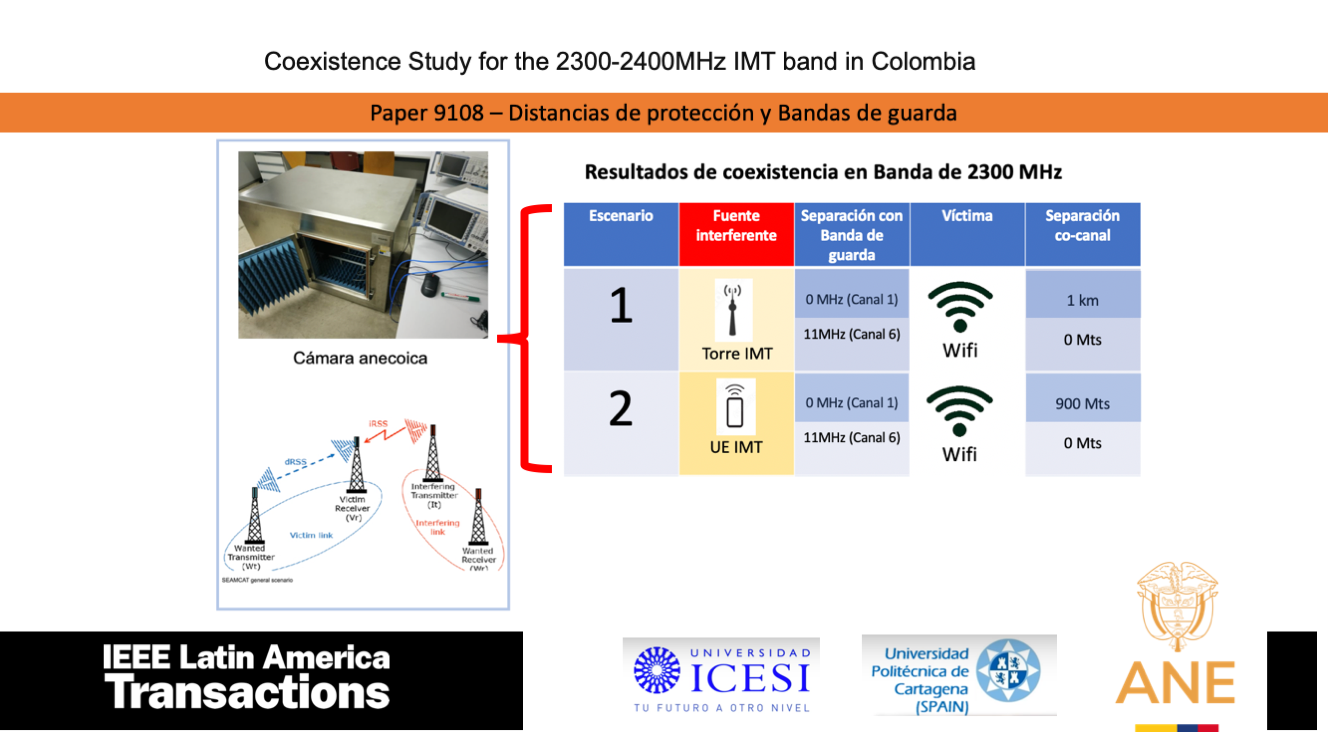Coexistence Study for the 2300-2400MHz IMT band in Colombia
Keywords:
Spectrum Management, Coexistence, IMT, WiFi, Radio Regulations, Interference analysisAbstract
The deployment of 5G services varies across the globe, in Europe, Asia, and North America have seen the most significant deployment, while some Latin American countries are still in the process. This review examines the regulations related to radio frequency bands and analyzes ways to optimize radio space in the 2300-2400 MHz band in Colombia. The findings and recommendations serve as a reference for similar countries in Latin America. Based on the results, it is recommended to maintain a minimum distance of 100 meters between IMT base stations and Bluetooth and ZigBee systems. For WiFi, it is advisable to use channels higher than 5 or ensure a separation of at least 1 kilometer. Indoors, no special attention is required due to wall attenuation. A separation of around 5 MHz is necessary between the two bands in laboratory tests. This ensures that the interference effects of IMT towards WiFi or vice versa stay within the acceptable limits of PER. The guard band should be established with respect to the LTE signal, which is the most restrictive case, and serves as the reference signal. In connection with band 40 of LTE, the guard band will be 0.6 MHz and 0.8 MHz with respect to the WLAN signal.
Downloads
References
Industry Canada, «Consultation on Renewal Process for 2300 MHz and 3500 MHz Licences». Accedido: 28 de julio de 2021. [En línea]. Disponible en: https://www.ic.gc.ca/eic/site/smt-gst.nsf/eng/sf10481.html
E. C. Committee, «Broadband wireless systems usage in 2300–2400 MHz», ECC Rep., vol. 172, 2012.
International Telecommunications Union, Recommendation ITU-R M.1036-5. Frequency arrangements for implementation of the terrestrial component of International Mobile Telecommunications (IMT) in the bands identified for IMT in the Radio Regulations (RR). 2015.
5G Americas, «Estado de las Bandas de Espectro Radioeléctrico en América Latina: 600 MHz, 700 MHz, 2300 MHz, 2500 MHz y 3500 MHz». Accedido: 28 de julio de 2021. [On line]. Available in: https://brechacero.com/download/2433/
GSMA Intelligence, «Spectrum management in Latin America: impacts on economic and social development». 2023. Accedido: 28 de octubre de 2023. [On line]. Available in: https://data.gsmaintelligence.com/research/research/research-2023/spectrum-management-in-latin-america-impacts-on-economic-and-social-development
Agencia Nacional del Espectro, «Cuadro Nacional de Atribución de Bandas». 2021. [On line]. Available in: https://portalespectro.ane.gov.co/Style%20Library/ane_master/cnabf-tecnico.aspx
GSMA, «GSMA Intelligence Spectrum Navigator, Q1 2021: New Insights and trends to watch». Accessed july : 29,2021. [On line]. Available in: https://www.gsma.com/spectrum/wp-content/uploads/2021/03/Spectrum-Navigator-Q1-2021.pdf
APT, «APT FREQUENCY ARRANGEMENT ON 2300 – 2400 MHz FOR IMT/BWA». april, 2010.
IFT Unidad de Espectro y Radioeléctrico, «Panorama del espectro radioeléctrico en México para servicios móviles de quinta generación». IFT, marzo de 2019. [On line]. Available in: https://www.ift.org.mx/sites/default/files/industria/temasrelevantes/14863/documentos/04-estudiouer5g-imt.pdf
W. Liu, J. Fang, H. Tan, B. Huang, y W. Wang, «Coexistence studies for TD-LTE with radar system in the band 2300–2400 MHz», en 2010 International Conference on Communications, Circuits and Systems (ICCCAS), jul. 2010, pp. 49-53. doi: 10.1109/ICCCAS.2010.5582021.
H. Tan, W. Liu, D. Meng, B. Huang, y W. Wang, «Coexistence studies for TD-SCDMA with radar sysetm in the band 2300–2400 MHz», en 2010 3rd IEEE International Conference on Broadband Network and Multimedia Technology (IC-BNMT), oct. 2010, pp. 451-456. doi: 10.1109/ICBNMT.2010.5705131.
M. Vaser, E. Ricci, G. Pierri, E. Restuccia, y G. Fusco, «Coexistence issues of 2300–2400 MHz band LTE signals and 2400–2500 MHz band Wi-Fi systems», en 2017 Ninth International Conference on Ubiquitous and Future Networks (ICUFN), jul. 2017, pp. 450-455. doi: 10.1109/ICUFN.2017.7993825.
R. Ekman et al., «Measurements to Study the Coexistence of Private LTE TDD Networks in 2.3 GHz Band», en 2021 29th Conference of Open Innovations Association (FRUCT), may 2021, pp. 102-108. doi: 10.23919/FRUCT52173.2021.9435513.
J. Kalliovaara et al., «Interference measurements for Licensed Shared Access (LSA) between LTE and wireless cameras in 2.3 GHz band», en 2015 IEEE International Symposium on Dynamic Spectrum Access Networks (DySPAN), sep. 2015, pp. 123-129. doi: 10.1109/DySPAN.2015.7343896.
M. Höyhtyä et al., «Spectrum Occupancy Measurements in the 2.3-2.4 GHz band: Guidelines for Licensed Shared Access in Finland», EAI Endorsed Trans. Cogn. Commun., vol. 1, n.o 2, may 2015, Accedido: 7 de julio de 2024. [En línea]. Disponible en: https://eudl.eu/doi/10.4108/cogcom.1.2.e2
Electronic Communications Committee, «ECC Report 252: Seamcat Handbook Edition 2». abril de 2016.


